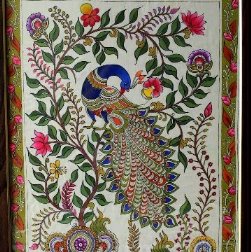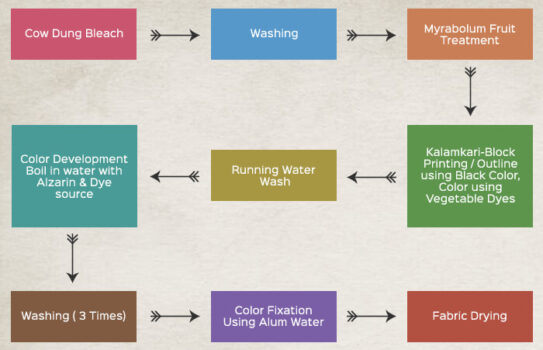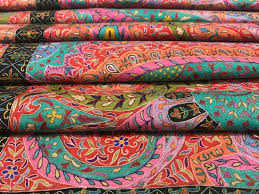Kalamkari Printing
Kalamkari Block Printing is an ancient style of hand block printing on fabric that is done on Cotton fabric known as Kalamkari cotton fabric. This type of hand printing originated in Isfahan, Iran, and in the Indian state of Andhra Pradesh. Kalamkari originates from a Persian word where the word “Kalam” means pen and “Kari” means Craftsmanship. The major forms of Kalamkari printing designs in India are Srikalhasti from the Chittoor district and Machilipatnam Kalamkari from the Krishna district.
History of Kalamkari Block Printing

In ancient India, folk singers and painters used to wander from one place to another, narrating stories of Hindu mythology to people. Slowly and slowly this process of telling tales to people turned into canvas painting and that is how Kalamkari art was developed.
The colorful art of Kalamkari block printing dates back to more than 3000 BC. According to historians, the colorful art of kalamkari block printing dates back to more than 3000 BC.
Fabric samples of Kalamkari art were found in Mohenjodaro.
It was during the Mughal era when this style of printing really got recognized. The Mughals promoted this art in the Golconda and Coromandel provinces where skillful craftsmen or Kalamkar practiced this art.
Under the Golconda sultanate, this art flourished at Machilipatnam in the Krishna district of Andhra Pradesh and further was promoted during the 18th century, as a decorative design on clothing by Britishers in India.
Pinchuk Veera Subbaiah, the founder of Kalamkari in Pedana. He started his first Kalamkari firm in 1972 in Pedana, which made and sold hand-block printed Kalamkari commercially.
Till today, many families in Andhra Pradesh continue to practice this art and this has served as the prime source of livelihood for them, over the generations.
The KalamKari Printing Process
The process of Kalamkari printing involves 23 steps. From the natural process of bleaching the fabric, softening it, sun drying, preparing natural dyes, and hand painting, to the processes of air drying and washing, the entire procedure is a process that requires precision and an eye for detailing.
In Kalamkari Fabric Printing, The cotton fabric is first treated with a solution of cow dung and bleach. After keeping the fabric in this solution for hours, the fabric gets a uniform off-white color.
After this, the cotton fabric is immersed in a mixture of buffalo milk and Myrobalans. This avoids smudging of dyes in the fabric when it is painted with natural dyes.
Later, the fabric is washed under running water to get rid of the odor of buffalo milk. The fabric likewise, is washed twenty times and dried under the sun. Once the fabric is ready for painting, artists sketch motifs and designs on the fabric.

Post this, the Kalamkari artists prepare dyes using natural sources to fill colors within the kalamkari drawings. Incorporating minute details, the Kalamkari use ‘tamarind twig’ as pen the main Kalamkari tool, to sketch beautiful motifs of Krishna Raas-Leela, Indian Gods and Goddesses like Parvati, Vishnu, Shri Jaganath; designs of peacock, lotus, and scenes from the Hindu epics like Mahabharata and Ramayana.
The Colors of Kalamkari Printing

The colors used in Kalamkari printing are earthly colors like indigo, rust, mustard, black and green. Natural dyes used to paint colors in Kalamkari art are extracted from natural sources without chemicals or artificial matter.
For instance, craftsmen extract black color by blending jaggery, water, and iron filings which they essentially use for outlining the sketches. While mustard or yellow is derived by boiling pomegranate peels, red hues are created from the bark of madder or Algirin. Likewise, blue is obtained from indigo, and green is derived by mixing yellow and blue together.
Types of Kalamkari Printing
There are two types of Kalamkari Printing in India:
- Srikalahasti style
- Machilipatnam style
Srikalahasti style of painting draws inspiration from Hindu mythology describing scenes from the epics and folklore. This style holds a strong religious connection because of its origin in the temples. In the Machilipatnam style of Kalamkari, motifs are essentially printed with hand-carved traditional wooden printing blocks with intricate detailing painted by hands. In more recent times two other types of Kalamkari wooden block printing have emerged in the states of Gujarat and Andhra Pradesh.
The Andhra Kalamkari borrows design inspiration from forts, palaces, and temples of India, along with motifs of animals and birds. While the Gujarat Kalamkari depicts motifs of mythological characters like Krishna-Arjuna from Mahabharata, Lord Krishna, Lord Ganesha, Lord Buddha, etc.
The present and the future
Kalamkari Block printing has come a long way from its representation of Kalamkari art as religious paintings. It gained recognition and peaked during the reign of the Mughal dynasty.
Today it is concentrated in the state of Andhra Pradesh which is the largest producer of Kalamkari Block printing. This art of block printing has come a long way from producing traditional kalamkari motifs of gods and goddesses on Kalamkari cotton fabrics to producing Kalamkari cotton sarees and blouses, Kalamkari kurtas, and kalamkari printing material online. Despite the emergence of technology machine looms and printed textiles which escalated the extinction process of this art, Kalamkari block printing has managed to survive due to the intervention of various fashion designers of the Indian fashion industry who came together to revive this art by helping the artisans practicing this art to survive.
If you love the idea of block printing for yourself and looking to buy wooden printing blocks, you can buy this Wooden Printing design and print your own fabric and paper.
We design, make, and sell our own wooden printing blocks, for block printing onto fabric, paper, clay, and mixed-media art products. Block Printing is an ancient Indian printing technique. Our wooden printing blocks are all hand-carved in the traditional Indian method, in India.
If you want to read more about Indian Traditional Printing Techniques like the art of block printing feel free to click on the hyperlink.
